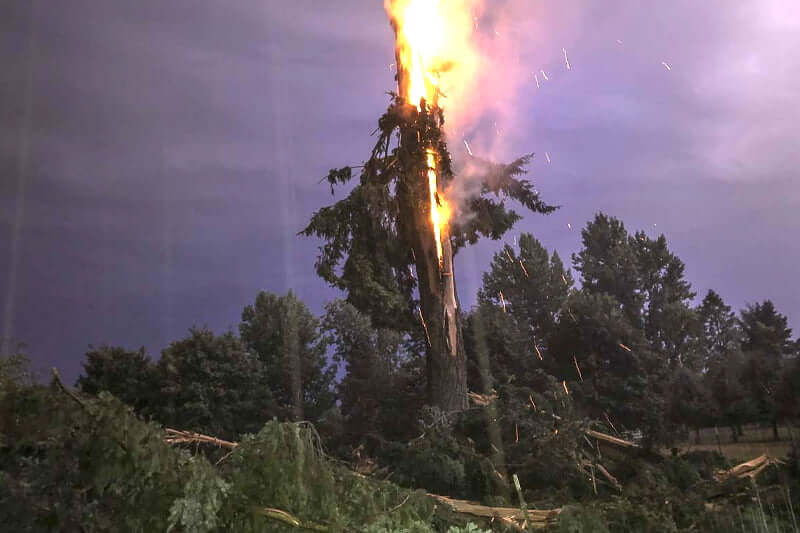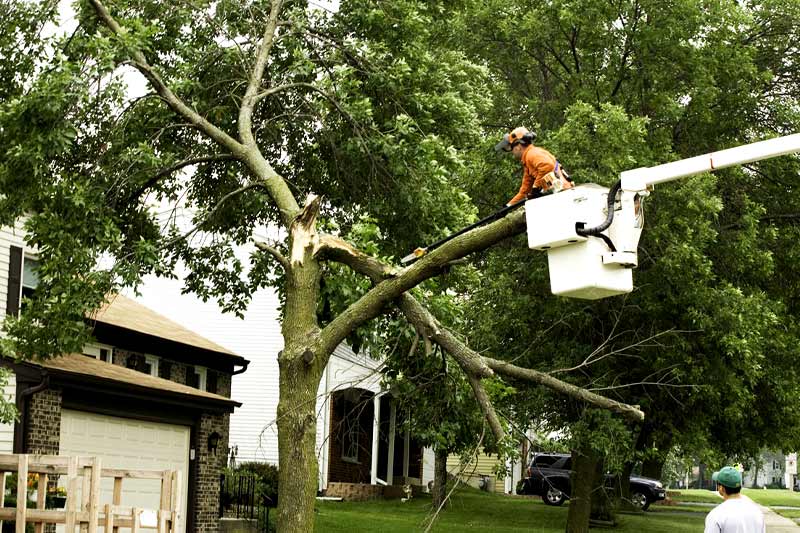Trees, especially those with impressive heights, are most likely to be targeted whenever lightning strikes. However, the height of the trees is not the only reason they are more likely to be struck.
Trees absorb water. The sap and moisture present inside make trees more prone to conducting and attracting lightning.
Additionally, the location, the type of tree, and the environmental conditions are also influences of this.

It can be pretty evident when a tree is struck by lightning. A tree can be left so damaged sometimes it shows barks wrecked – even the trunk. In some cases, it goes up in flames for a long time.
However, evidence of a lightning strike can be very subtle as well. It is particularly the inside of the tree the lightning is targeting, so most of the time, it can go unnoticeable when a tree has been struck by lightning.
In some cases, it takes days or even weeks for trees to die slowly without even showing signs of being struck by lightning. There are also times when a tree instantly dies after it has been struck.
Trees are not very good electrical conductors, but their resistance to electricity flow is what causes the production of heat within, causing trunks to sometimes break in half. Caused by this electrical resistance, the sap in the tree overheats.
If the lightning has struck deep within the tree, the whole tree could explode immediately. This is most likely to happen with trees that are highly absorbent to water.
Here are some common indicators that a tree has been damaged by lightning:
- A crack or slit runs down the trunk
- Burnt, wilted, and/or sparse leaves
- Burnt and blackened areas of bark and trunk
- Chunks of bark shattered into pieces
Trees that are susceptible to lightning strike also depend on their location. Here are some locations where a tree is most likely struck:
- Open areas
- Near a body of water
- Edge of a forest or stand of trees
- Hilltop
- Mountainside
- Near a building
Can a tree survive a lightning strike?
Many trees can survive a lightning strike. While some trees are unfortunately unable to overcome the damages caused by lightning and need removal, the survival of a tree depends on its health, species, age, and location.
A tree will most likely survive when only one side of it has been destroyed, but even then, the tree must be taken care of after being struck by lightning as it has experienced stress and damage.
When a tree has been left wounded, it leaves an entrance for insects and diseases caused by microorganisms. This could cause the tree to decline over time which is why it should be treated and cared for a little more than usual.
With proper care and maintenance, a wounded tree caused by lightning will still survive and could continue to live for many years. There are some trees that have been struck by lightning multiple times and still survived.
However, if both sides of the tree are damaged, the probability of it surviving is close to zero.
How to fix a tree hit by lightning?
Prune the tree
The first step in fixing a tree hit by lightning is to remove any obviously damaged or burned branches. Prune out any hanging, broken branches, and torn wood, but do not do it extensively.
Provide supplemental nutrients
Damaged trees need to absorb supplemental nutrients. The second step is to ensure you provide the tree with enough water and start fertilizing it to stimulate growth.
It is important to note that you get the best fertilizer for the kind of tree you are repairing. Do not put too much fertilizer; over-fertilization can hurt the tree as it can cause soil and root damage.
Continue inspecting the tree
As you maintain these two steps in the process of repairing a tree, observe it for the next 2 to 6 months. Whether the tree needs extensive corrective pruning or removal, you have to wait a few months to assess the actual damage.
Sometimes, even after having done months of watering and fertilizing, the tree may not still survive, especially when it has been exposed to insects and diseases.
For a much more accurate assessment, you can schedule a consultation with a professional arborist. With this, you will be able to develop a healthcare treatment for your tree after having it evaluated by a professional.

Can lightning strikes on a tree be prevented?
Preventing a tree from being struck by lightning is possible. In fact, this process is actually better and easier than repairing a damaged tree that has been struck.
Lightning protection systems can be installed to protect trees that are most susceptible to a lightning strike. These systems can also be installed on trees you just want to protect, specifically those that are located in residential areas.
While lightning protection systems can be expensive, they are worth the investment especially when you live in an area prone to having storms. These systems are not only able to protect the tree, but they are also capable of protecting your property.
How lightning protection systems work
A lightning protection system does its job by slowly releasing the electrical charge caused by the lightning, and letting it dissipate before it becomes detrimental to the tree it is protecting.
A tree is protected by the system with an air terminal placed on top of the tree, a cable conductor made of copper that runs down from the trunk to the ground, and a ground-rod system placed a safe distance away from the tree.
If lightning strikes the tree (installed with a system), it can direct the electrical current through the copper cable conductor and dissipate it safely onto the ground.
Should you have any trees near the homes that you think are vulnerable to lightning or you want to protect your property, you can contact your local arborist to know your options on the protection of these trees.



